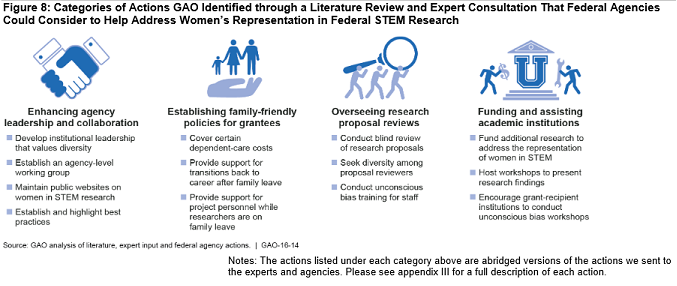The federal government gives nearly $25 billion a year to universities to conduct cutting-edge research in science, technology, engineering, and math—commonly called STEM—fields. But studies show that women are still largely underrepresented in these fields.
Given the underrepresentation, are the billions of dollars the government spends on STEM research each year distributed equitably to male and female scientists?
For Pi Day (3/14), the WatchBlog is doing the math on
women’s access to STEM funding and explaining why this answer is so hard to find.
An incomplete picture
If you want to know whether STEM research money is being distributed equitably to men and women researchers, you could try to compare women’s success rates in applying for federal funding with men’s.
When we tried to do just that, we encountered a major roadblock—only 3 of the 6 largest federal science agencies keep track of the data we needed to calculate these success rates.
 (Excerpted from GAO-16-14)
(Excerpted from GAO-16-14)
What does that mean? It means that NIH, NSF, and USDA can demonstrate that there is no evidence of disparities in the success rates between women and men applying for their STEM research funding.
But DOD, DOE, and NASA can’t do the same. For these agencies,
we recommended improvements in data collection and retention to allow for a better understanding of potential bias in their funding decisions.
Title IX? Isn’t that about sports?
Many people have heard of Title IX in relation to college sports. What fewer people realize is that Title IX goes beyond the playing field. It also prohibits sex discrimination in federally funded education programs, including STEM research.
As it turns out, we found that DOD and NIH have not conducted legally required reviews to determine if the universities they fund are complying with Title IX in their STEM programs. This means that
more than half of the federal dollars flowing into universities for STEM research could potentially be left more vulnerable to sex discrimination.
This does not, of course, mean that discrimination is occurring at these universities, but without these reviews NIH and DOD can’t be sure. They are missing opportunities to identify potential discrimination, improve procedures, and build capacity to uphold a non-discriminatory environment.
Breaking down the barriers
Beyond ensuring compliance with Title IX, there are several additional actions federal agencies could take to address barriers women can face when pursuing STEM careers.
 (Excerpted from GAO-16-14)
(Excerpted from GAO-16-14)
While none of these actions is a silver bullet, the 6 science agencies we reviewed are all taking action in some of these areas and officials at most of the agencies expressed a willingness to do more.
For information on the differences between women and men who received federal funding for STEM research, the percent of STEM PhDs awarded to women, and many more facts and figures about women in STEM, check out our
full report.
 (Excerpted from GAO-16-14)
(Excerpted from GAO-16-14) (Excerpted from GAO-16-14)
(Excerpted from GAO-16-14)
